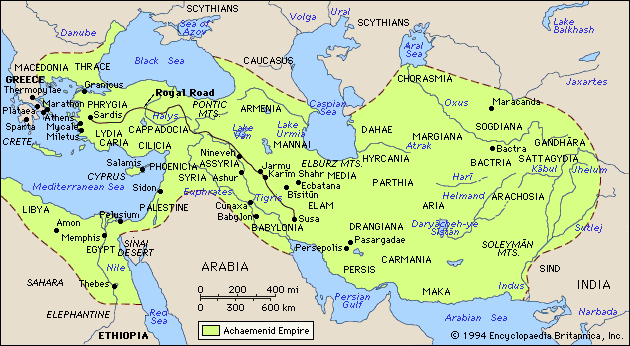
The Persian Empire (559 - 330 B.C.)
Egypt, Babylonia, and Assyria were many centuries old when the mountain-walled plateau region south of the Caspian Sea was settled by a nomadic people from the grasslands of Central Asia in approximately 1000 BC. Although the newcomers called themselves Irani (Aryans) and their new homeland Irania (now Iran), the land came to be called Persia, because Greek geographers mistakenly named it after the province Pars, or Persis, where their early kings had their capital.
The early Persians and their close relatives, the Medes, resembled the Semite peoples of the Middle East, but they spoke a different language. While the Semites spoke various Semitic languages, such as Arabic, Hebrew, and Assyrian, the languages of the Persians and Medes were Indo-Iranian—that is, they belonged to a group of languages that is more closely related to modern-day European languages than to Semitic tongues. Although both the Medes and Persians had worshiped nature gods, in the 6th century BC they began to follow the teachings of the prophet Zoroaster
The Achaemenian Dynasty (559-330 BC)
By the 6th century BC, the Medes had built a large empire that included the Persians to the east and the Assyrians to the west. However, in 550 BC Cyrus the Great of Persia conquered the Medes, acquiring Assyria in the process, which the Median King Cyarxes had taken in about 612 BC. The formidable armies of Cyrus battled their way to more victories, notably the conquest of Lydia, then ruled by King Croesus (see Croesus). This victory gave Cyrus possession of the Greek seaboard cities of Asia Minor. In 539 BC Babylon, capital of the Chaldean Empire, surrendered to Cyrus without a fight; in conquering Babylon, Cyrus also acquired Palestine. He allowed the Jews to return from Babylonian exile and rebuild their temple in Jerusalem. Turning eastward, Cyrus expanded his empire to the border of India. He was killed fighting against eastern nomads in 529 BC and was buried in a tomb he had prepared at his capital, Pasargadae.
Cyrus' son Cambyses II, who ruled from 529 to 522 BC, successfully crossed the hostile Sinai Peninsula on his way to conquering Egypt in a short campaign. After his death, the crown of Persia was seized in 522 BC by Darius.
Under Darius, the Persian Empire flourished. His most notable accomplishment was perfecting the system of government begun by Cyrus. The empire was divided into 20 satrapies, or provinces, each ruled over by a satrap. Officials known as the king's eyes made regular visits to the satrapies and reported their observations to the king. The satrapies furnished soldiers for the king's armies. Phoenicia, Egypt, and the Greek colonies of Asia Minor also supplied ships and sailors. In addition, each satrap paid a fixed yearly tribute to Darius. 
Enormous wealth flowed into the royal treasure houses of Susa, Persepolis, Pasargadae, and Ecbatana. When the king required money, he minted gold coins. To encourage commerce Darius standardized coins, weights, and measures; built imperial highways; and completed a canal from the Nile River to the Red Sea. He demanded strict enforcement of the severe laws of the Medes and Persians.
Throughout his reign Darius was forced to suppress revolts in the empire. In 500 BC the Greek cities of Asia Minor rebelled. After putting down this rebellion, Darius turned on Athens to punish it for sending aid to the rebels. Beaten in the famous battle of Marathon, he prepared another expedition but died in 486 BC before it started.
Xerxes, the son of Darius, ruled from 486 to 465 BC. He was a tyrannical king who began his reign by quelling rebellions in Egypt and Babylon, then gathered a huge force to overwhelm Greece. It seemed as if the mighty empire would conquer the small, disunited Greek city-states. Yet Xerxes met disaster at Salamis and Plataea, and his great army was driven back into Asia (see Persian Wars). This defeat marked the first sign of decay in the Persian Empire. Persian history for the next 125 years was filled with conspiracies, assassinations, and the revolts of subject peoples ground down by ruinous taxation. The empire was briefly united under the bloodthirsty Artaxerxes III (originally Ochus), who ruled from about 359 to 338 BC. He killed many of his relatives and was then poisoned by his own physician. His son Arses, who succeeded him, was poisoned two years later and all his children slain.
Darius III was on the throne when Alexander the Great of Macedon led his powerful army into Asia (see Alexander the Great). In the decisive battle of Issus in 333 BC, Alexander captured the western half of the Persian Empire. Darius fled from the battlefield. He met Alexander again at Arbela, in 331 BC, and fled once more. Soon afterward one of Darius' own followers murdered him. Alexander went on to conquer other lands, but Persia remained under his control until his death in 323 BC. While Persia continued to flourish as a nation, the days of the great Persian Empire were over. (Student Encyclopaedia Britannica Article)